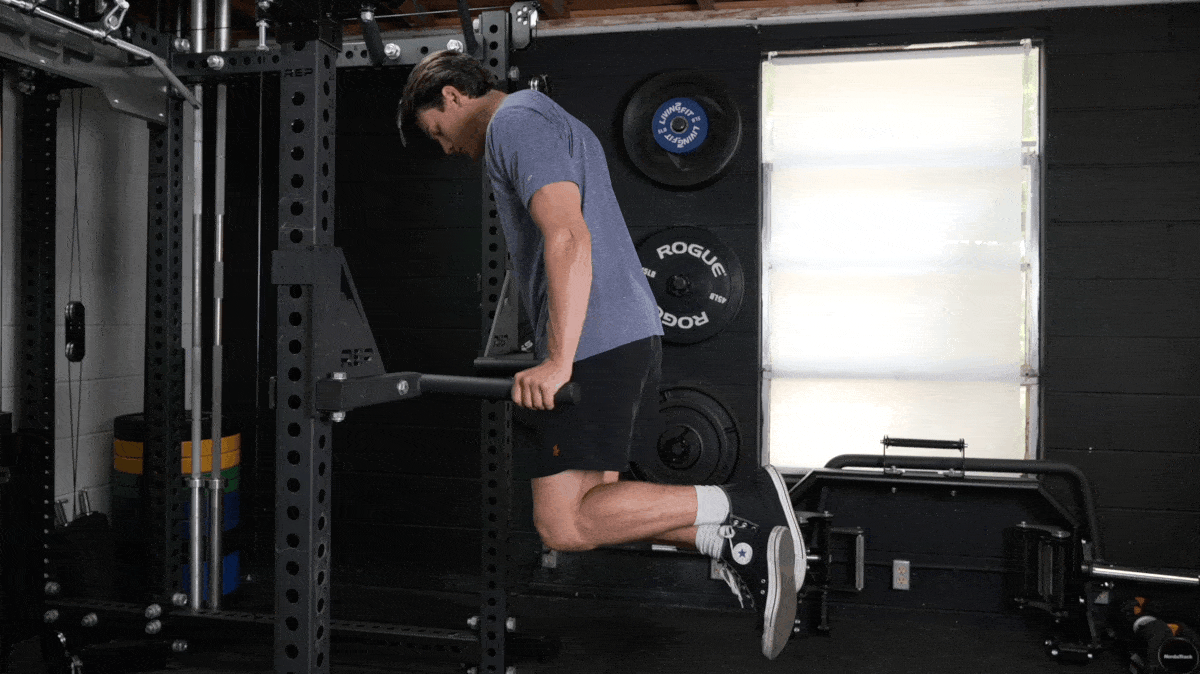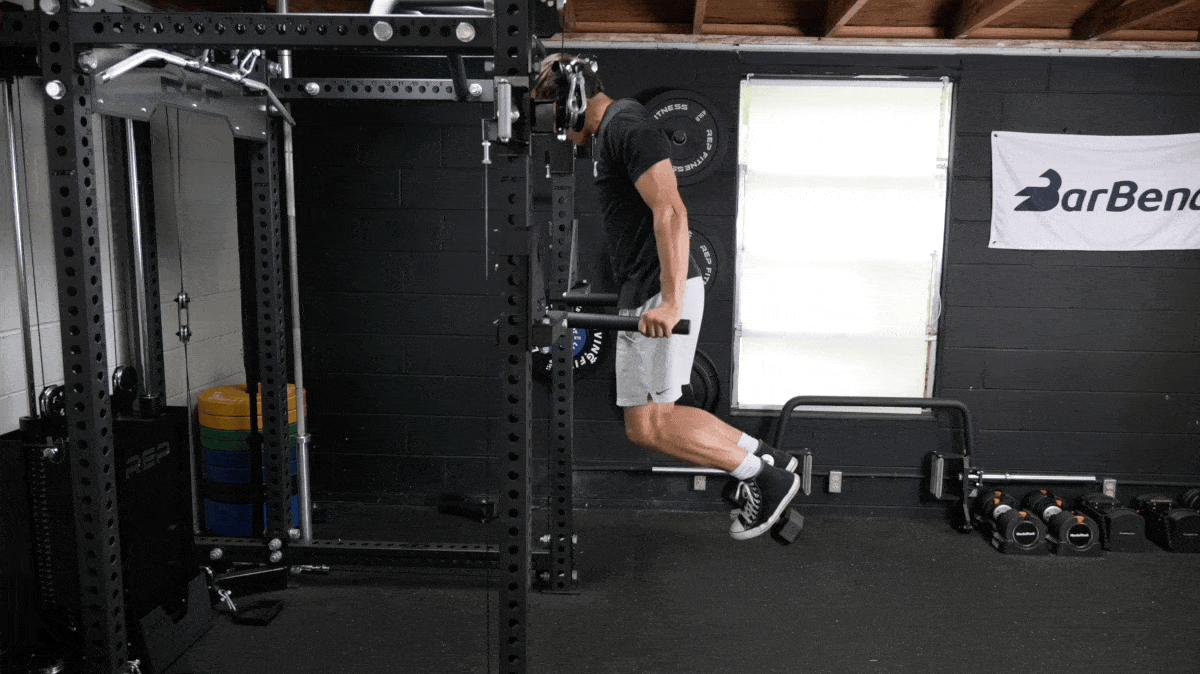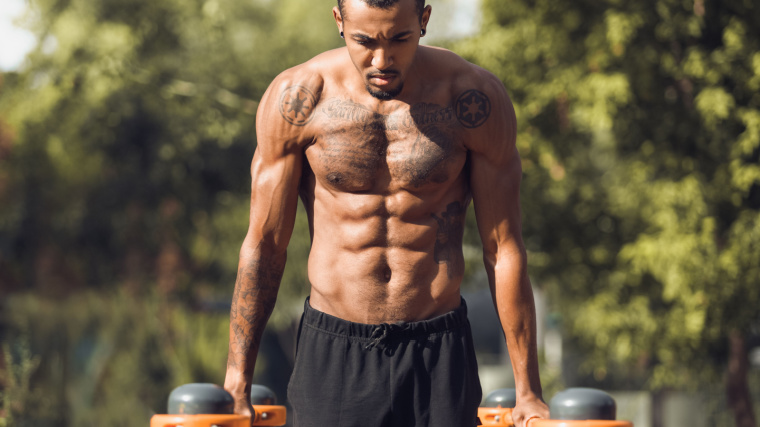If you want to develop serious upper body strength, drive muscle growth, and improve your lockout performance in the bench press, there is one lift to rule them all — the dip. This is a simple movement that can bring about truly massive gains. All you need is a dip bar and plenty of strength.
That said, it’s pretty tough to perform a dip. As with pull-ups, many lifters aspire to complete their first full dip for quite a while. This guide will take you through all you need to know about dips, whether you’re aiming to lock out your first rep or trying to get even more out of the ever-powerful weighted dip.
How to Do the Dip

- Step 1 — Stand between the dip bars, ideally ones that allow your hands to be relatively within two inches outside of shoulder width. Set your hands evenly on the bars. Squeeze your shoulder blades together and squeeze the bars hard.
- Step 2 — Flex your elbows and lower your body, keeping your torso upright and your core tight until your elbows are bent at 90 degrees.
- Step 3 — Drive through your palms to raise your body back to the starting position. Your torso should be nearly vertical, with perhaps a slight lean forward. Flex your triceps hard at the top. Repeat for reps.
Why Do It: The dip is both a measure and builder of upper body strength, with a special emphasis on strengthening your chest and triceps. Having trouble with your bench press lockout? Dips may well help you bust through that plateau.
Equipment Needed: Dip bar
Dip Variations
Below are three dip variations you can do to improve strength, size, and overall muscle growth of the chest, triceps, and upper body.
Elevator Dips
[Read More: The Best Shoulder Exercises for Building Muscle]
- Start at the top of the lift and sink down until you reach the halfway point in your range of motion (with your arms at about 45 degrees).
- Pause there for a second, then continue down your repetition until you reach the bottom of the lift.
- Press back up to the midway point, pausing again at about 45 degrees.
- Lock out at the top of the lift. Repeat for reps.
Weighted Dips

[Read More: How to Do the Lat Pulldown for a Wider Back and Better Pull-Ups]
- Secure a dip belt around your waist and add your desired amount of weight plates.
- Perform dips as usual.
- If you don’t have access to a dip belt, you can hold a dumbbell between your thighs or ankles.
Ring Dips
[Read More: The Best Online Workout Programs For Coaching, Cardio, Value, And More]
- Adjust a pair of gymnastics rings so that they’re at about the same height as the dip bar you’re used to working on.
- With a hand in each ring, hop up to the starting position. Stabilizing at lockout here will be much more challenging than it is with a dip bar, so make sure you’re steady before dipping down.
- Perform your dips as you usually would, taking care to not let your form slip as your body fights the unstable base of the rings.
Dip Alternatives
Below are three dip alternatives that you can try out to vary your programming and simulate the results of dips without a dip bar.
Close-Grip Push-Up
[Read More: Build a Titanic Torso with These Bodybuilding Chest & Back Workouts]
- Set up on the floor in a plank position. Place your hands slightly closer than shoulder-width apart. Depending on your body shape, you might want to bring them in under your chest.
- Sink down into a push-up, keeping your elbows tucked close to your torso. Keep your core, glutes, and quads tight to maintain your body position.
- Press up through your hands to lockout. Repeat for reps.
Handstand Push-Up
[Read More: Use the Bent-Over Row to Make Big Gains With Big Weights]
- Place your hands about six inches from a wall, a little farther than shoulder-width apart.
- Kick one foot up to to wall, followed by the other. Find stability with your heels touching the wall and your legs and core rigid.
- Slowly lower down so your head moves toward a pad or the floor, keeping your elbows inward at about 30 to 45 degrees.
- Press upward from the bottom position, keeping your core tight and your legs pressed together. Repeat for reps.
Floor Press
[Read More: What Are Workout Splits? Top 3 Most Effective Routines]
- Lie on your back on the floor underneath a loaded barbell at eye level. Whether you bend your knees or keep your legs straight, maintain contact on the floor with your hips, upper back, and feet.
- Squeeze the barbell, pulling your elbows down toward your torso. When the backs of your arms touch the floor, reverse the movement so you’re tense and ready to heft the weight.
- Press the weight up until your elbows are fully extended. Maintain your body position throughout.
- Lower your elbows back to the floor and repeat for reps.
Who Should Do the Dip?
Anyone, really, as long as they have the requisite strength and range of motion. Below are the main athletes who can benefit from adding dips to their routines.
- Powerlifters and Strongman Athletes: Use the dip to develop the triceps, a vital muscle group during the bench press and other overhead pressing movements. Using the dip to isolate the triceps (and even the chest) can help to enhance further muscle hypertrophy and aid in overall upper body strength and mass development.
- Olympic Weightlifters: The triceps are key in proper elbow extension and overhead lockout strength. Stronger triceps will often correlate with greater overhead stability and strength in the snatch and jerk positions.
- CrossFitters: Ring dips are a huge component of many CrossFitters’ routines. You can use this move to help prepare you for a full ring muscle-up, too. Further, the dip can increase upper body strength and development, aiding in increasing overhead stability and pressing performance.
Dip Sets and Reps
- For Hypertrophy: Start by performing three to five sets of eight to 15 repetitions, with 90 to 120-second rest times with moderate to heavy loads. This rep range ensures your triceps are under tension for the right amount of time. If your body weight is no longer a challenge, you’ll need to add weight to your dips.
- To Increase Strength: To gain strength, you’ll want to add weight via a dip belt. Do three to five sets of five to 10 repetitions with 90 to 120-second rest periods with moderate to heavy loads. Manipulating lifting tempos, loads, and partial ranges of motion (at times) can all be used to facilitate more strength development.
- To Improve Muscle Endurance: Endurance is all about performing a lot of reps with a short rest time. Do two to three sets of 20 to 30 repetitions with 45 to 60-second rest with light to moderate loads.
Benefits of the Dip
If you start to incorporate dips into your routine, here are three benefits you can expect to gain.
Improved Lockout Strength
The triceps are involved in elbow extension, which is the final phase of movements like the bench press, jerk, overhead press, push press, handstand push-up, and more. Often, lifters who struggle with the lockout phases of a movement need to add accessory movements to their training program to help shore up any weaknesses.
Greater Overhead Stability
The triceps help stabilize the elbows in the overhead position, making them a key muscle group to develop (in addition to the stabilizers of the wrist, scapular region, and shoulders) for overhead athletes. More overhead stability is key for weightlifters and CrossFitters, specifically in the top positions of snatches and clean & jerks.
Bigger Arms and Chest
The triceps muscle takes up more than half of the arm, which means the larger those triceps get, the larger your arms get. For those of you on a quest for 22-inch pipes, be sure to work your triceps hard, as they will contribute greater arm size than the biceps.

[Read More: Get Freakishly Strong With the 5×5 Workout Program]
The chest is also a key player in the dip toward the bottom of the movement. So, the dip equally taxes the chest muscle for more size and strength.
Muscles Worked by the Dip
The dip is an upper-body exercise that can add strength and muscle mass to the triceps and chest. That said, it may also add some volume to the anterior shoulder as well.
- Triceps: The triceps are used to lift the lifter upwards as they are responsible for elbow extension. The dip is a good exercise to target the long and lateral heads of the triceps and can be a key triceps exercise for muscle growth.
- Pectorals: The pectoral muscles (chest) are targeted during the dip and aid the triceps in pushing the lifter upwards. When done properly, this can help target the lower pecs.
- Front Delts: In most pressing movements, the front deltoid (shoulder) is used. Some individuals may find the dip can aggravate or tax the anterior shoulder capsule, which may mean your form is incorrect, or you need to do other exercises to isolate the triceps and pecs.
Common Dip Mistakes
It’s a simple up-and-down movement, but you’ll want to get the technique right for the most gains.
Going Too Low
With each rep, you’ll want to go down to parallel or slightly below parallel. But there can be too much of a good thing. Dipping too much deeper can put stress on your shoulder joints that you can easily avoid. By staying in that sweet spot just a hair below parallel, you’ll maximize chest and triceps engagement while not unintentionally taxing your shoulders.
Not Going Low Enough
You can absolutely do partial reps with dips. Deployed strategically — as with elevator dips — they can help you build maximum strength by bringing you very close to failure. That’s great news for your muscle growth. That said, aim to go parallel or slightly below parallel with each rep that’s not meant to be a partial rep. This will maximize muscle engagement and growth.
Letting Your Chest Sink
You do want to lean slightly forward with the dip because it’ll engage your chest very deeply. That said, if you lean too far forward, you risk inappropriately engaging your shoulders. To find your sweet spot, aim for a position that gives you a stretch in your chest at the bottom of the rep with a very tight core. Maintaining core integrity will help keep you in an optimal position.
FAQs
Dips may be tough, but with the right amount of knowledge — and practice — you can add them to their repertoire successfully.
When training dips at home, without a dip bar, you can do bench dips or close-grip push-ups to get a similar muscular loading and hypertrophy effect on the triceps and chest.
Dips are not inherently bad for the shoulders. However, the dip can sometimes aggravate the shoulders in some individuals. While this can often be remedied with learning proper technique, lifters can also swap out dips for movements like close-grip bench presses, close-grip push-ups, and cable pushdowns to hit the triceps muscle in a similar manner as the dip.
Generally speaking, adding weight to the dip can be beneficial to gain strength and muscle. I recommend training no less than five reps per set, which means the weight itself can vary based on your strength.
Featured Image: Syda Productions/Shutterstock